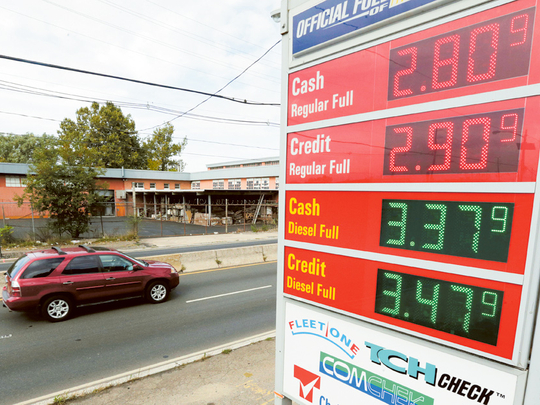
It is often the basic concepts that can explain the most sophisticated and controversial of issues, like the current drop in oil prices.
Many op-eds talked about Economics 101, or 201, and how it’s crucial to understand that a surplus in supply would result in a continuous decline in price as long as demand stays stagnant, or it doesn’t increase in a way that meets increasing supply.
Once the two meet, prices will stop dropping, sure. This might be the case, but let’s explore the numbers a bit more and see where that will take us.
First, I took the 2012 oil production levels from the US Energy Information Administration (EIA). I then matched these with the consumption levels of the same top 20 producers to determine at who’s a net exporter, who’s a net importer, and who’s more likely to import or export any time soon.
The top two were the US and China, and since it’s a given that China is not even among the top three producers — and with its oil demand expected to keep growing — I shifted the focus to the US. This is not because of what was just mentioned or because it has always been a major importer of oil, but mainly because of its production levels being on the rise since oil was extracted first in the 1860s.
We are talking here about 6,000 barrels per day in 1864 and more than 8.5 million barrels a day in 2014. Note here that the latest trend is still on the rise.
When looking at the gap between US production and consumption of oil, and even when taking imports into account, net imports have been on the decline since 2005 and now relies on foreign oil for a mere 33 per cent of its consumption. To understand this, let’s consider the US’ main providers of oil as documented by EIA along with the percentages.
Canada tops the list with 28 per cent, followed by Saudi Arabia (13 per cent), Mexico (10 per cent), Venezuela (9 per cent), and Russia (5 per cent). The first point is that all of those countries are among the top exporters in the list mentioned earlier, and they are all net exporters of oil.
Secondly, and when combining the stake of the two Opec members here, Saudi Arabia and Venezuela, the combined stake puts them at 22 per cent, second only to Canada. The reason why I classified them as such is for the role Opec members have played in the past when trying to either drop or raise oil prices.
Also, the fact that OPEC’s oil exports represent some 60 per cent of oil traded internationally. And within Opec, it’s the major producer, Saudi Arabia, which can have a major say in oil price shifts, whether upwards or downwards.
Historically, Adam Smith discussed how world supply and demand can affect the price of different commodities. With gold and silver, the discovery of new mines affects the price downwards due to a surge in supply.
The one point that should be highlighted here is that abundance in supply, with almost no regard to demand, will for sure drop the price. This is not the entire story though. In the 1970s, a couple of events that took place triggered price hikes that lead to shortages in major economies and to the appearance and build-up of long queue lines for gasoline.
Starting from there, a few things changed for good. Opec back then controlled a percentage of the oil market that made it possible to have a say in what prices should be at. Secondly, all countries that suffered shortages and long queue lines realised the importance of diversifying away from a sole major source.
Back then was the end of cheap oil, or at least the initial phase of it. With shale oil being nowhere to be found, and later on too expensive to be searched for and extracted, Opec was the key player and still is, at least psychologically, as it has around 80 per cent of proven oil reserves.
So far, we have established an increased role for the US and other new entrants in the oil market. It was also pointed out how prices could be influenced in one way or another based on the controlled market share. Adding to that, and exploiting another part of the truth, let’s consider the oil price that countries need to sell at for budget purposes.
That is, the price below which countries run a deficit and above which they run a surplus. Appearing in the Wall Street Journal, starting from the highest is Iran at $140 a barrel, Venezuela and Algeria at $121, Nigeria at $119, Ecuador at $117, Iraq at $106, Angola at $98, Saudi Arabia at $93, Libya at $90, Kuwait at $75, the UAE at $70, and Qatar at $65.
With price fluctuating between $80 and $85, you can easily spot who is losing money by the day, who is managing things fine, and who is still making money. Going back to the initial point mentioned earlier, what happens when the price is below that needed to balance a country’s budget and hence creates a deficit? Well, this is where it gets complicated.
The first and easiest thing to tap into is the central bank’s cash reserves. In Nigeria for instance, this has been the case for some time now. The second possible thing to do is to hike interest rates to attract foreign currencies as well as prevent capital flight.
The third would be to devalue the currency, if it wasn’t pegged to the dollar that is. Also, in the case of Nigeria, Bloomberg reported that there cash reserves has dropped from $39.7 billion at the beginning of September to $39.3 billion now.
As for the remaining countries from the list above and who might be running deficits for some time now, it mainly comes down to how much cash reserves you can burn through before sounding the alarm. Why is that?
Because raising interest rates can be damaging to economic activities, and devaluing a currency can lay the ground for higher future inflation rates. That being said, all you got to do now is to go and dig deep into who owns what cash.
An op-ed in ‘Foreign Policy’ listed different countries that may be negatively affected and the standing of the sovereign wealth funds. Why?
Something very similar to what’s happening now happened in the 1980s. According to EIR Economics, that was the first time the concept of cutting down supplies was less relevant. In fact, transactions were conducted based on contracts that were signed for a certain period of time and then renewed.
The process was referred to as “net-back” basis. Back then, and now, speculation existed on new market entrants who would flood the markets with oil supply. The concern, back then and now too, was about maintaining a market share even if that meant losing an acceptable amount per barrel.
By acceptable I mean deficits that can be supported by central bank’s cash reserves. Will oil prices drop further? That can only be measured using the same logic of what caused the current drop to begin with.
Right now, many countries are feeling the pain of the current “cheap oil” era. In Canada, “25 per cent of the synthetic crude produced from the sands is no longer profitable” (Bloomberg). In the US, 12 shale oil projects are losing money and four are barely in breakeven. If Russia can balance its budget out at an oil price of $114, as reported by CNBC, this cannot be good.
Three years ago, disruptions in regional oil production facilitated the way for others to raise their production capacities, each with different quantities. This alone makes it hard enough to cut back, so how about losing market share altogether without a decent increase in oil price?
It was only recently that the US abolished its 40-year ban to export oil. Other oil producers, where previous disruptions had taken place, are now back online and are in for business.
Many long-time oil producers are pumping oil at maximum capacities that were not realised before. But if history can teach us anything, it would be that it gets, at least partially, repeated.
The two tough lessons that most will come out of this, if they ever do come out of it, is that: one, you can’t keep dancing because the music hasn’t stopped playing yet, and, two, you should always stash some cash away for oily days, especially if you are highly dependent on it for revenues.
The thought that I want to leave you with is this: what can a stronger dollar mean in the midst of all this? And what difference does it make to have a country’s currency pegged to it or not?
The writer is a commercial consultant and a commentator on economic affairs. You can follow him on Twitter at www.twitter.com/aj_alshaali












